Understanding Business Organization: Advantages and Disadvantages of Different Types of Business, Organizational Structures, Business Functions, and Organizational Culture
VerifiedAdded on 2023/06/18
|9
|2252
|167
AI Summary
This report discusses the advantages and disadvantages of different types of business organizations such as sole trader, partnership, limited company, etc. It also compares and contrasts organizational structures, discusses different business functions such as human resource management, production, operations, and explains how positive organizational culture impacts the success of an organization. The report includes a corporate example of Zara and Marks & Spencer.
Contribute Materials
Your contribution can guide someone’s learning journey. Share your
documents today.
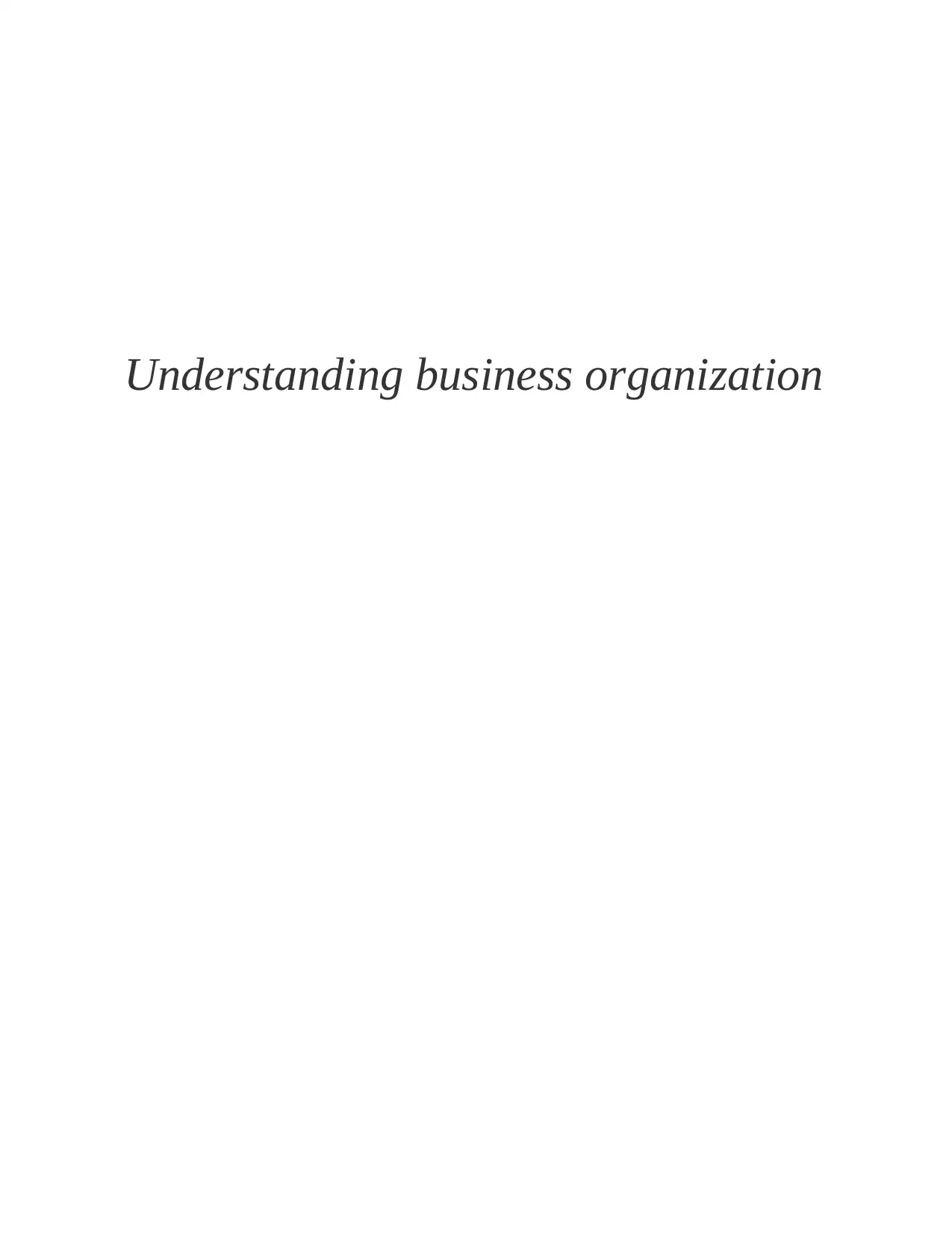
Understanding business organization
Secure Best Marks with AI Grader
Need help grading? Try our AI Grader for instant feedback on your assignments.
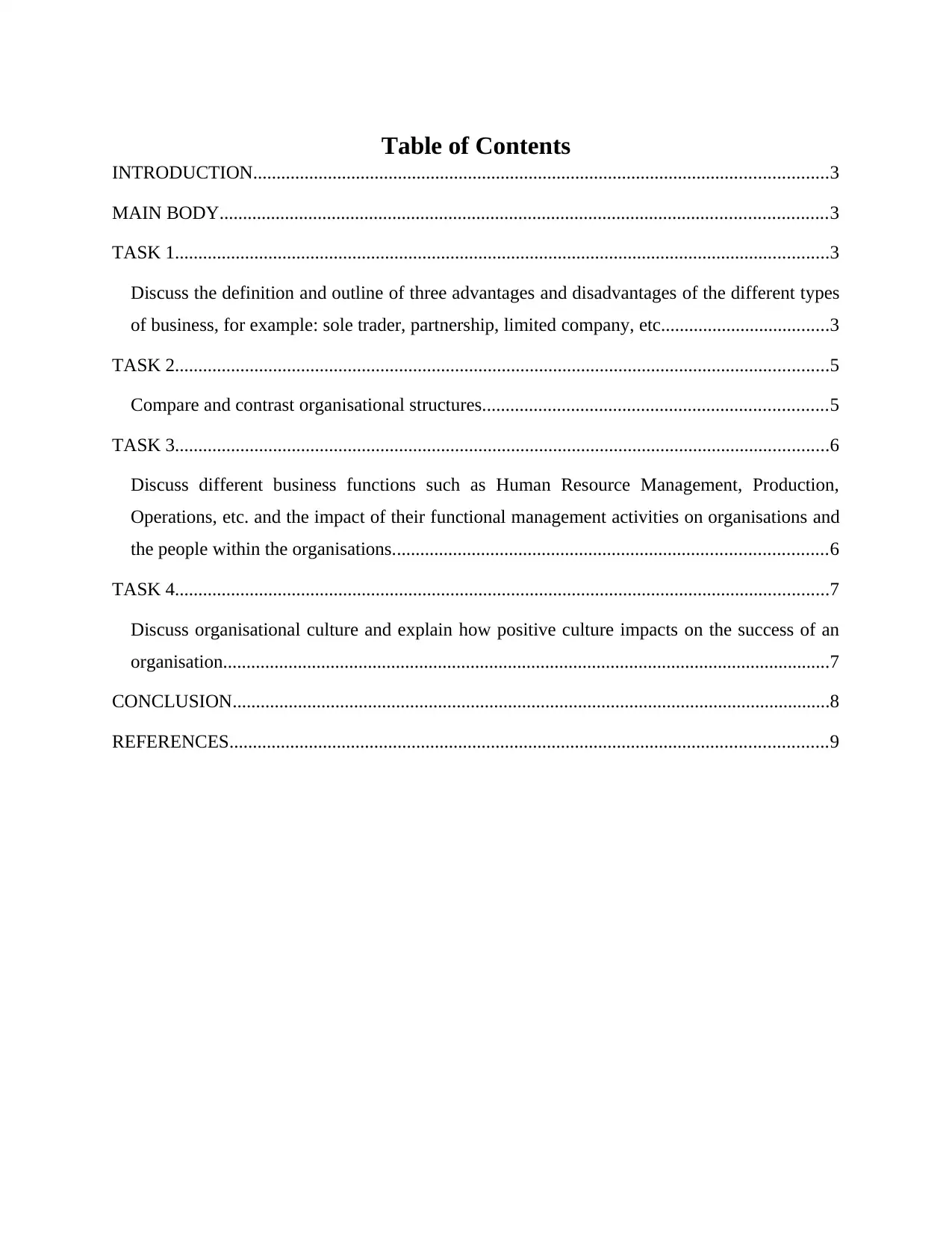
Table of Contents
INTRODUCTION...........................................................................................................................3
MAIN BODY..................................................................................................................................3
TASK 1............................................................................................................................................3
Discuss the definition and outline of three advantages and disadvantages of the different types
of business, for example: sole trader, partnership, limited company, etc....................................3
TASK 2............................................................................................................................................5
Compare and contrast organisational structures..........................................................................5
TASK 3............................................................................................................................................6
Discuss different business functions such as Human Resource Management, Production,
Operations, etc. and the impact of their functional management activities on organisations and
the people within the organisations.............................................................................................6
TASK 4............................................................................................................................................7
Discuss organisational culture and explain how positive culture impacts on the success of an
organisation..................................................................................................................................7
CONCLUSION................................................................................................................................8
REFERENCES................................................................................................................................9
INTRODUCTION...........................................................................................................................3
MAIN BODY..................................................................................................................................3
TASK 1............................................................................................................................................3
Discuss the definition and outline of three advantages and disadvantages of the different types
of business, for example: sole trader, partnership, limited company, etc....................................3
TASK 2............................................................................................................................................5
Compare and contrast organisational structures..........................................................................5
TASK 3............................................................................................................................................6
Discuss different business functions such as Human Resource Management, Production,
Operations, etc. and the impact of their functional management activities on organisations and
the people within the organisations.............................................................................................6
TASK 4............................................................................................................................................7
Discuss organisational culture and explain how positive culture impacts on the success of an
organisation..................................................................................................................................7
CONCLUSION................................................................................................................................8
REFERENCES................................................................................................................................9
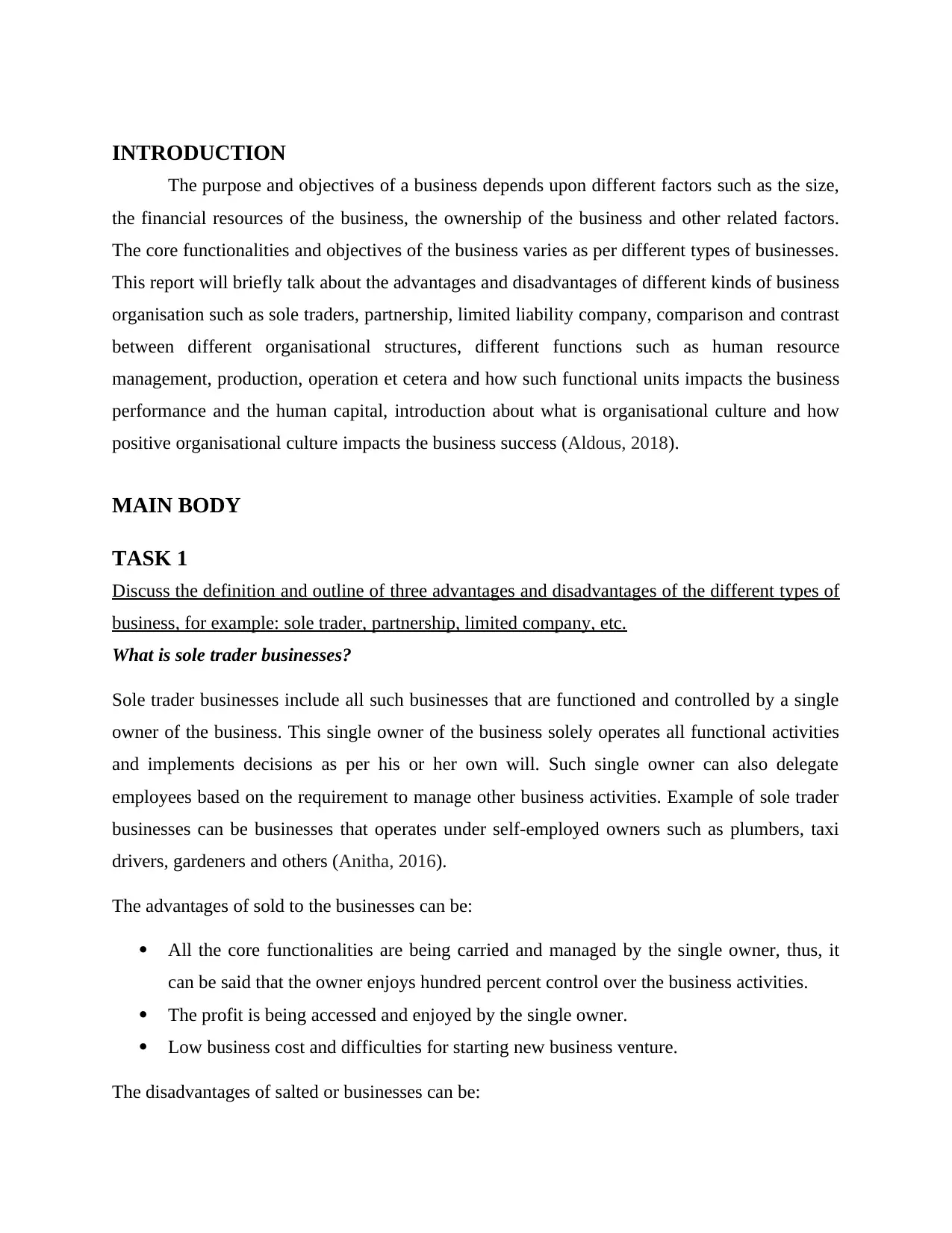
INTRODUCTION
The purpose and objectives of a business depends upon different factors such as the size,
the financial resources of the business, the ownership of the business and other related factors.
The core functionalities and objectives of the business varies as per different types of businesses.
This report will briefly talk about the advantages and disadvantages of different kinds of business
organisation such as sole traders, partnership, limited liability company, comparison and contrast
between different organisational structures, different functions such as human resource
management, production, operation et cetera and how such functional units impacts the business
performance and the human capital, introduction about what is organisational culture and how
positive organisational culture impacts the business success (Aldous, 2018).
MAIN BODY
TASK 1
Discuss the definition and outline of three advantages and disadvantages of the different types of
business, for example: sole trader, partnership, limited company, etc.
What is sole trader businesses?
Sole trader businesses include all such businesses that are functioned and controlled by a single
owner of the business. This single owner of the business solely operates all functional activities
and implements decisions as per his or her own will. Such single owner can also delegate
employees based on the requirement to manage other business activities. Example of sole trader
businesses can be businesses that operates under self-employed owners such as plumbers, taxi
drivers, gardeners and others (Anitha, 2016).
The advantages of sold to the businesses can be:
All the core functionalities are being carried and managed by the single owner, thus, it
can be said that the owner enjoys hundred percent control over the business activities.
The profit is being accessed and enjoyed by the single owner.
Low business cost and difficulties for starting new business venture.
The disadvantages of salted or businesses can be:
The purpose and objectives of a business depends upon different factors such as the size,
the financial resources of the business, the ownership of the business and other related factors.
The core functionalities and objectives of the business varies as per different types of businesses.
This report will briefly talk about the advantages and disadvantages of different kinds of business
organisation such as sole traders, partnership, limited liability company, comparison and contrast
between different organisational structures, different functions such as human resource
management, production, operation et cetera and how such functional units impacts the business
performance and the human capital, introduction about what is organisational culture and how
positive organisational culture impacts the business success (Aldous, 2018).
MAIN BODY
TASK 1
Discuss the definition and outline of three advantages and disadvantages of the different types of
business, for example: sole trader, partnership, limited company, etc.
What is sole trader businesses?
Sole trader businesses include all such businesses that are functioned and controlled by a single
owner of the business. This single owner of the business solely operates all functional activities
and implements decisions as per his or her own will. Such single owner can also delegate
employees based on the requirement to manage other business activities. Example of sole trader
businesses can be businesses that operates under self-employed owners such as plumbers, taxi
drivers, gardeners and others (Anitha, 2016).
The advantages of sold to the businesses can be:
All the core functionalities are being carried and managed by the single owner, thus, it
can be said that the owner enjoys hundred percent control over the business activities.
The profit is being accessed and enjoyed by the single owner.
Low business cost and difficulties for starting new business venture.
The disadvantages of salted or businesses can be:
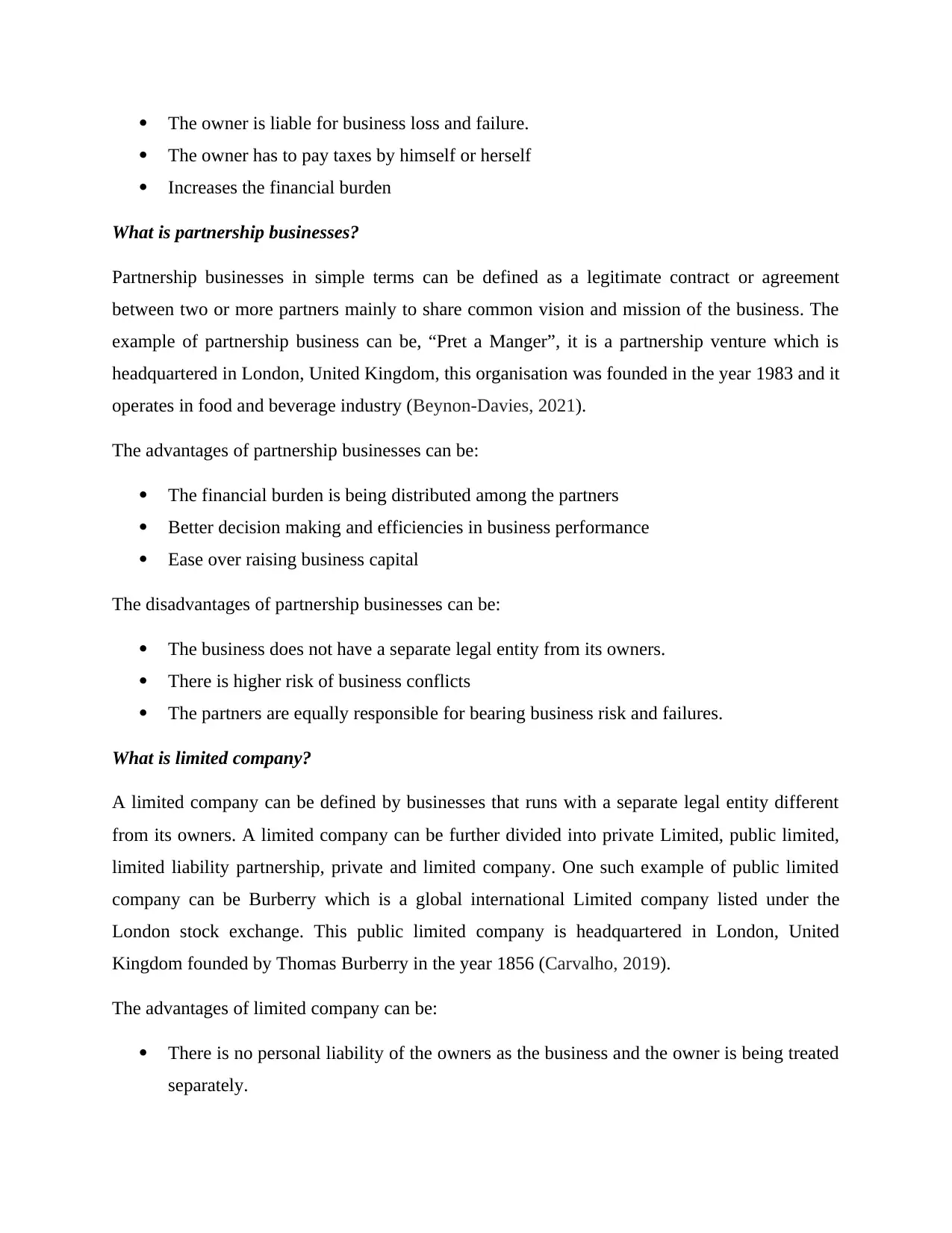
The owner is liable for business loss and failure.
The owner has to pay taxes by himself or herself
Increases the financial burden
What is partnership businesses?
Partnership businesses in simple terms can be defined as a legitimate contract or agreement
between two or more partners mainly to share common vision and mission of the business. The
example of partnership business can be, “Pret a Manger”, it is a partnership venture which is
headquartered in London, United Kingdom, this organisation was founded in the year 1983 and it
operates in food and beverage industry (Beynon-Davies, 2021).
The advantages of partnership businesses can be:
The financial burden is being distributed among the partners
Better decision making and efficiencies in business performance
Ease over raising business capital
The disadvantages of partnership businesses can be:
The business does not have a separate legal entity from its owners.
There is higher risk of business conflicts
The partners are equally responsible for bearing business risk and failures.
What is limited company?
A limited company can be defined by businesses that runs with a separate legal entity different
from its owners. A limited company can be further divided into private Limited, public limited,
limited liability partnership, private and limited company. One such example of public limited
company can be Burberry which is a global international Limited company listed under the
London stock exchange. This public limited company is headquartered in London, United
Kingdom founded by Thomas Burberry in the year 1856 (Carvalho, 2019).
The advantages of limited company can be:
There is no personal liability of the owners as the business and the owner is being treated
separately.
The owner has to pay taxes by himself or herself
Increases the financial burden
What is partnership businesses?
Partnership businesses in simple terms can be defined as a legitimate contract or agreement
between two or more partners mainly to share common vision and mission of the business. The
example of partnership business can be, “Pret a Manger”, it is a partnership venture which is
headquartered in London, United Kingdom, this organisation was founded in the year 1983 and it
operates in food and beverage industry (Beynon-Davies, 2021).
The advantages of partnership businesses can be:
The financial burden is being distributed among the partners
Better decision making and efficiencies in business performance
Ease over raising business capital
The disadvantages of partnership businesses can be:
The business does not have a separate legal entity from its owners.
There is higher risk of business conflicts
The partners are equally responsible for bearing business risk and failures.
What is limited company?
A limited company can be defined by businesses that runs with a separate legal entity different
from its owners. A limited company can be further divided into private Limited, public limited,
limited liability partnership, private and limited company. One such example of public limited
company can be Burberry which is a global international Limited company listed under the
London stock exchange. This public limited company is headquartered in London, United
Kingdom founded by Thomas Burberry in the year 1856 (Carvalho, 2019).
The advantages of limited company can be:
There is no personal liability of the owners as the business and the owner is being treated
separately.
Secure Best Marks with AI Grader
Need help grading? Try our AI Grader for instant feedback on your assignments.
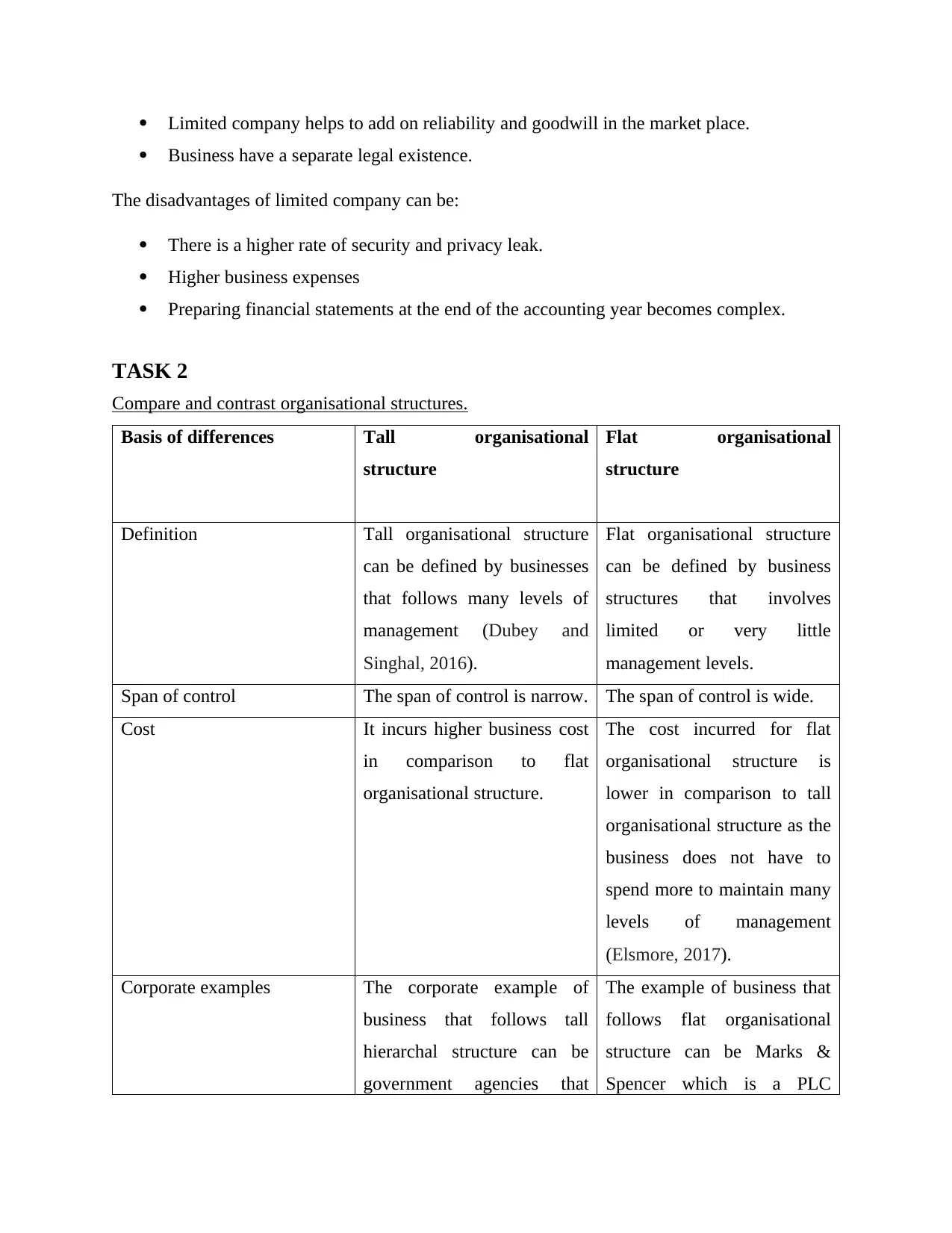
Limited company helps to add on reliability and goodwill in the market place.
Business have a separate legal existence.
The disadvantages of limited company can be:
There is a higher rate of security and privacy leak.
Higher business expenses
Preparing financial statements at the end of the accounting year becomes complex.
TASK 2
Compare and contrast organisational structures.
Basis of differences Tall organisational
structure
Flat organisational
structure
Definition Tall organisational structure
can be defined by businesses
that follows many levels of
management (Dubey and
Singhal, 2016).
Flat organisational structure
can be defined by business
structures that involves
limited or very little
management levels.
Span of control The span of control is narrow. The span of control is wide.
Cost It incurs higher business cost
in comparison to flat
organisational structure.
The cost incurred for flat
organisational structure is
lower in comparison to tall
organisational structure as the
business does not have to
spend more to maintain many
levels of management
(Elsmore, 2017).
Corporate examples The corporate example of
business that follows tall
hierarchal structure can be
government agencies that
The example of business that
follows flat organisational
structure can be Marks &
Spencer which is a PLC
Business have a separate legal existence.
The disadvantages of limited company can be:
There is a higher rate of security and privacy leak.
Higher business expenses
Preparing financial statements at the end of the accounting year becomes complex.
TASK 2
Compare and contrast organisational structures.
Basis of differences Tall organisational
structure
Flat organisational
structure
Definition Tall organisational structure
can be defined by businesses
that follows many levels of
management (Dubey and
Singhal, 2016).
Flat organisational structure
can be defined by business
structures that involves
limited or very little
management levels.
Span of control The span of control is narrow. The span of control is wide.
Cost It incurs higher business cost
in comparison to flat
organisational structure.
The cost incurred for flat
organisational structure is
lower in comparison to tall
organisational structure as the
business does not have to
spend more to maintain many
levels of management
(Elsmore, 2017).
Corporate examples The corporate example of
business that follows tall
hierarchal structure can be
government agencies that
The example of business that
follows flat organisational
structure can be Marks &
Spencer which is a PLC
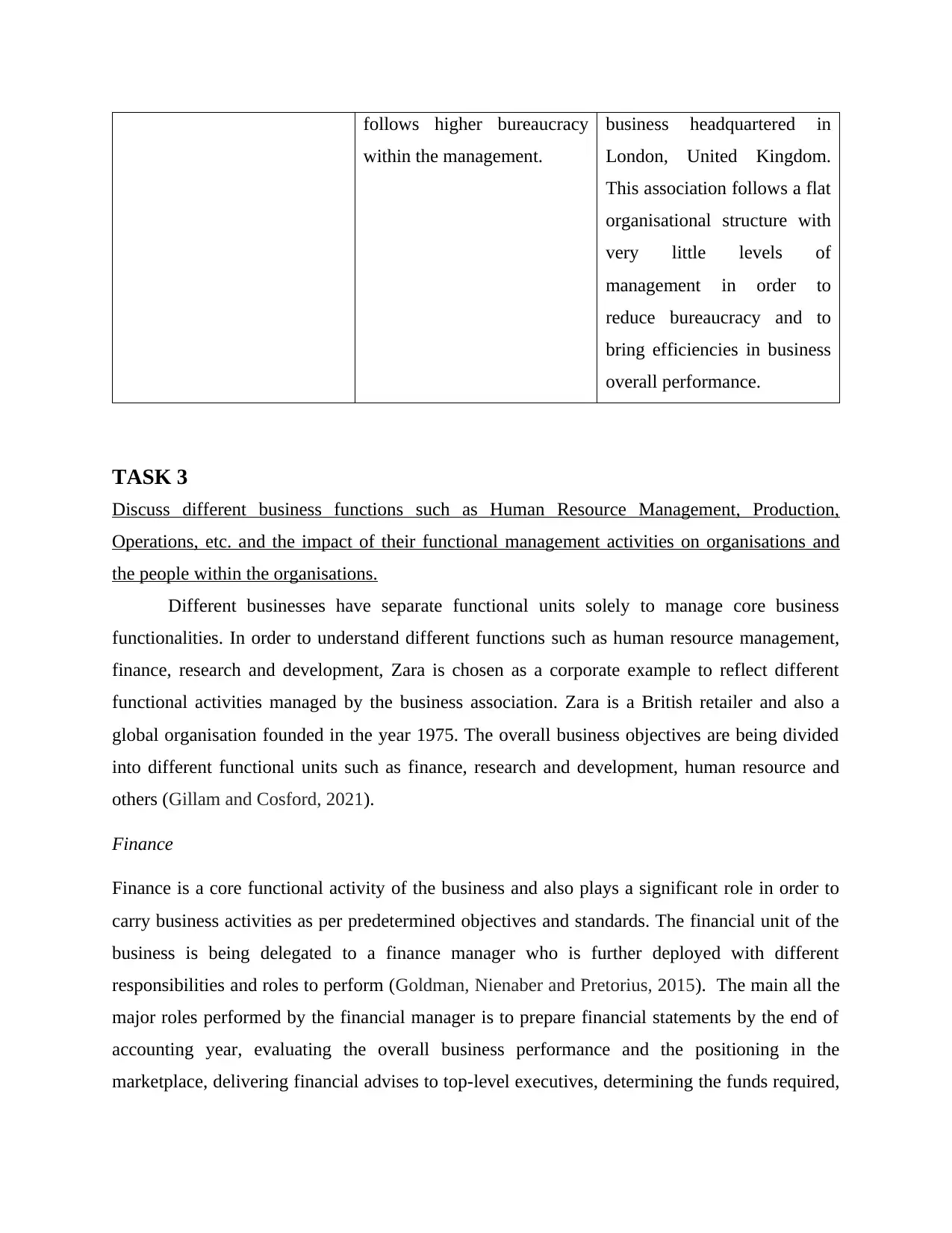
follows higher bureaucracy
within the management.
business headquartered in
London, United Kingdom.
This association follows a flat
organisational structure with
very little levels of
management in order to
reduce bureaucracy and to
bring efficiencies in business
overall performance.
TASK 3
Discuss different business functions such as Human Resource Management, Production,
Operations, etc. and the impact of their functional management activities on organisations and
the people within the organisations.
Different businesses have separate functional units solely to manage core business
functionalities. In order to understand different functions such as human resource management,
finance, research and development, Zara is chosen as a corporate example to reflect different
functional activities managed by the business association. Zara is a British retailer and also a
global organisation founded in the year 1975. The overall business objectives are being divided
into different functional units such as finance, research and development, human resource and
others (Gillam and Cosford, 2021).
Finance
Finance is a core functional activity of the business and also plays a significant role in order to
carry business activities as per predetermined objectives and standards. The financial unit of the
business is being delegated to a finance manager who is further deployed with different
responsibilities and roles to perform (Goldman, Nienaber and Pretorius, 2015). The main all the
major roles performed by the financial manager is to prepare financial statements by the end of
accounting year, evaluating the overall business performance and the positioning in the
marketplace, delivering financial advises to top-level executives, determining the funds required,
within the management.
business headquartered in
London, United Kingdom.
This association follows a flat
organisational structure with
very little levels of
management in order to
reduce bureaucracy and to
bring efficiencies in business
overall performance.
TASK 3
Discuss different business functions such as Human Resource Management, Production,
Operations, etc. and the impact of their functional management activities on organisations and
the people within the organisations.
Different businesses have separate functional units solely to manage core business
functionalities. In order to understand different functions such as human resource management,
finance, research and development, Zara is chosen as a corporate example to reflect different
functional activities managed by the business association. Zara is a British retailer and also a
global organisation founded in the year 1975. The overall business objectives are being divided
into different functional units such as finance, research and development, human resource and
others (Gillam and Cosford, 2021).
Finance
Finance is a core functional activity of the business and also plays a significant role in order to
carry business activities as per predetermined objectives and standards. The financial unit of the
business is being delegated to a finance manager who is further deployed with different
responsibilities and roles to perform (Goldman, Nienaber and Pretorius, 2015). The main all the
major roles performed by the financial manager is to prepare financial statements by the end of
accounting year, evaluating the overall business performance and the positioning in the
marketplace, delivering financial advises to top-level executives, determining the funds required,
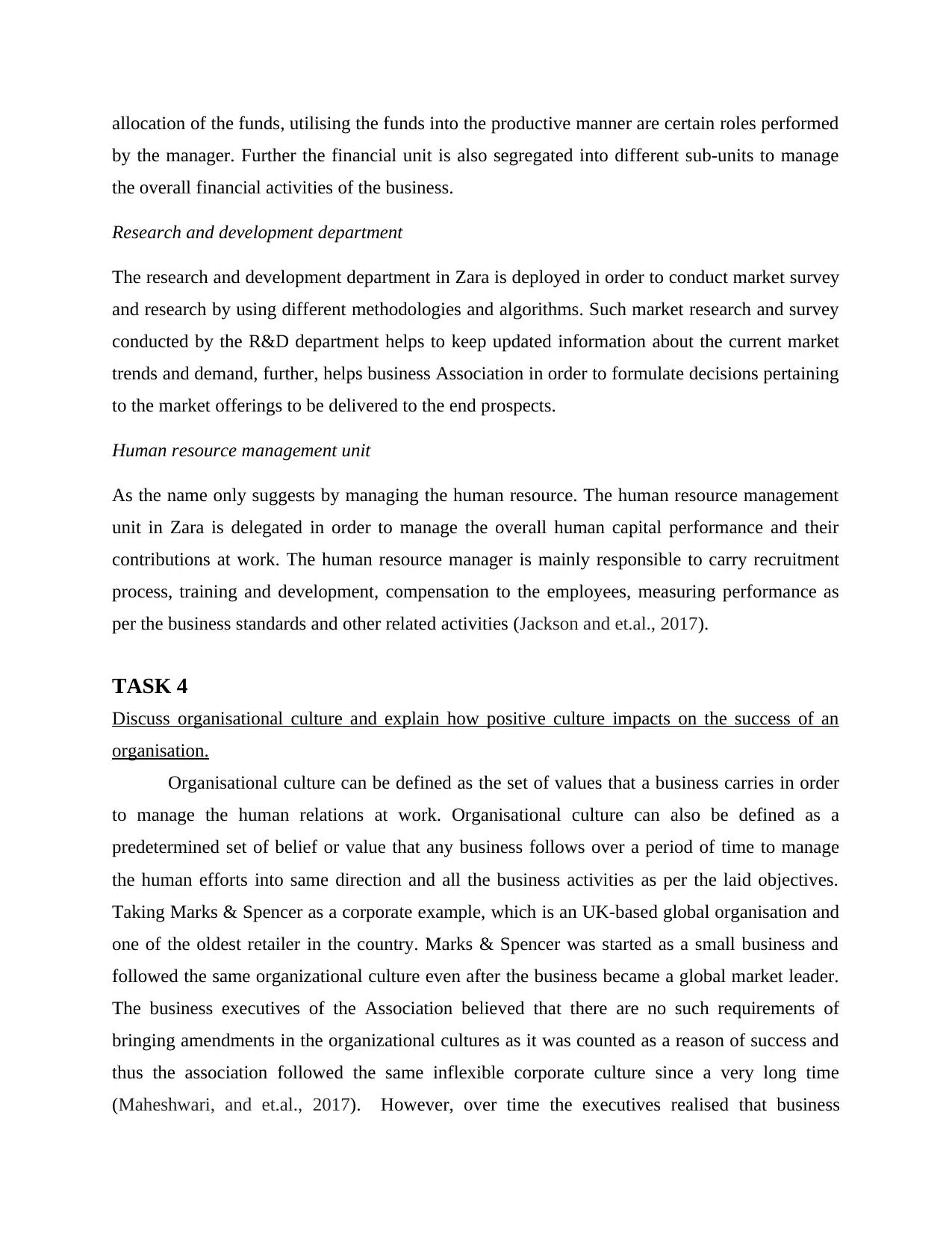
allocation of the funds, utilising the funds into the productive manner are certain roles performed
by the manager. Further the financial unit is also segregated into different sub-units to manage
the overall financial activities of the business.
Research and development department
The research and development department in Zara is deployed in order to conduct market survey
and research by using different methodologies and algorithms. Such market research and survey
conducted by the R&D department helps to keep updated information about the current market
trends and demand, further, helps business Association in order to formulate decisions pertaining
to the market offerings to be delivered to the end prospects.
Human resource management unit
As the name only suggests by managing the human resource. The human resource management
unit in Zara is delegated in order to manage the overall human capital performance and their
contributions at work. The human resource manager is mainly responsible to carry recruitment
process, training and development, compensation to the employees, measuring performance as
per the business standards and other related activities (Jackson and et.al., 2017).
TASK 4
Discuss organisational culture and explain how positive culture impacts on the success of an
organisation.
Organisational culture can be defined as the set of values that a business carries in order
to manage the human relations at work. Organisational culture can also be defined as a
predetermined set of belief or value that any business follows over a period of time to manage
the human efforts into same direction and all the business activities as per the laid objectives.
Taking Marks & Spencer as a corporate example, which is an UK-based global organisation and
one of the oldest retailer in the country. Marks & Spencer was started as a small business and
followed the same organizational culture even after the business became a global market leader.
The business executives of the Association believed that there are no such requirements of
bringing amendments in the organizational cultures as it was counted as a reason of success and
thus the association followed the same inflexible corporate culture since a very long time
(Maheshwari, and et.al., 2017). However, over time the executives realised that business
by the manager. Further the financial unit is also segregated into different sub-units to manage
the overall financial activities of the business.
Research and development department
The research and development department in Zara is deployed in order to conduct market survey
and research by using different methodologies and algorithms. Such market research and survey
conducted by the R&D department helps to keep updated information about the current market
trends and demand, further, helps business Association in order to formulate decisions pertaining
to the market offerings to be delivered to the end prospects.
Human resource management unit
As the name only suggests by managing the human resource. The human resource management
unit in Zara is delegated in order to manage the overall human capital performance and their
contributions at work. The human resource manager is mainly responsible to carry recruitment
process, training and development, compensation to the employees, measuring performance as
per the business standards and other related activities (Jackson and et.al., 2017).
TASK 4
Discuss organisational culture and explain how positive culture impacts on the success of an
organisation.
Organisational culture can be defined as the set of values that a business carries in order
to manage the human relations at work. Organisational culture can also be defined as a
predetermined set of belief or value that any business follows over a period of time to manage
the human efforts into same direction and all the business activities as per the laid objectives.
Taking Marks & Spencer as a corporate example, which is an UK-based global organisation and
one of the oldest retailer in the country. Marks & Spencer was started as a small business and
followed the same organizational culture even after the business became a global market leader.
The business executives of the Association believed that there are no such requirements of
bringing amendments in the organizational cultures as it was counted as a reason of success and
thus the association followed the same inflexible corporate culture since a very long time
(Maheshwari, and et.al., 2017). However, over time the executives realised that business
Paraphrase This Document
Need a fresh take? Get an instant paraphrase of this document with our AI Paraphraser
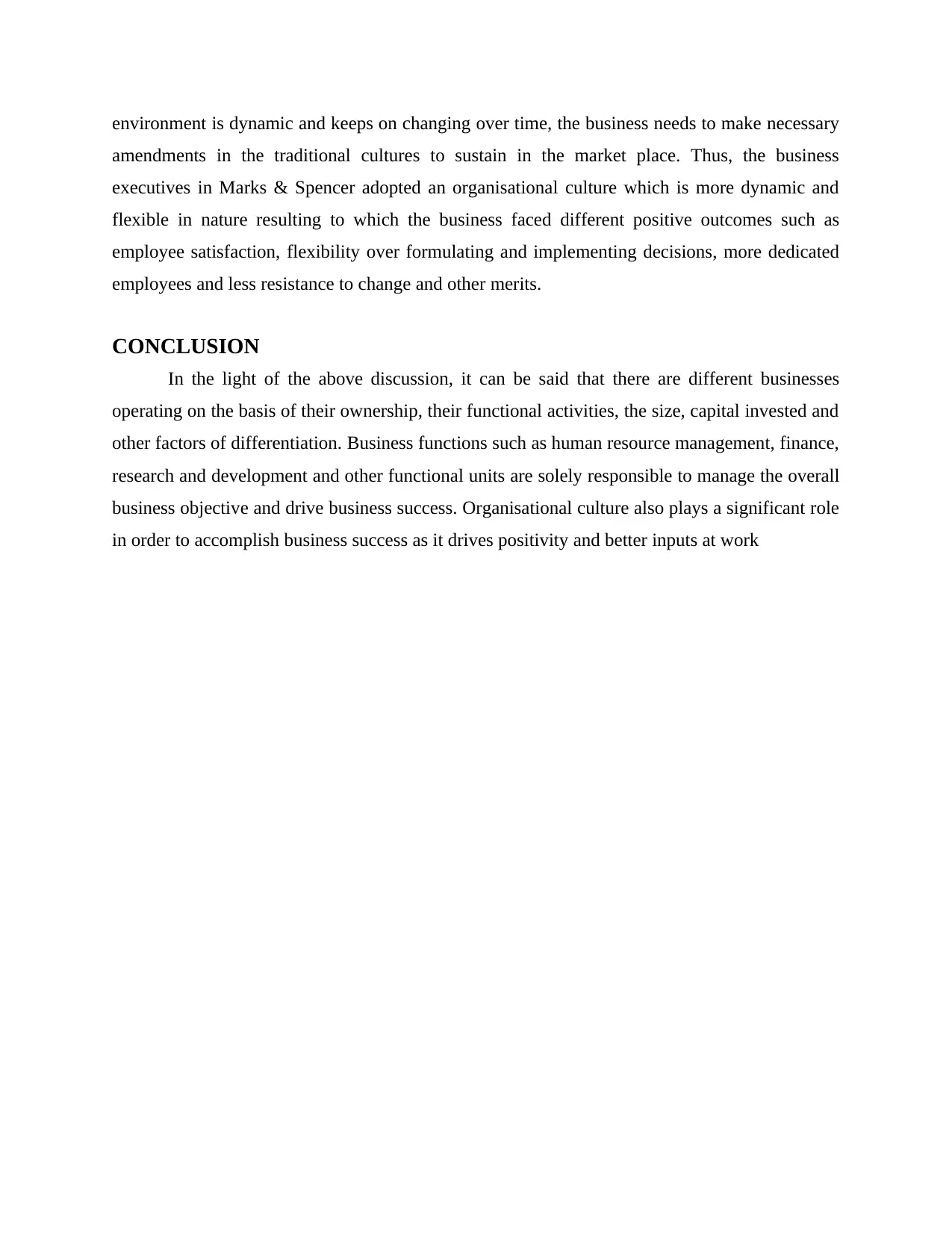
environment is dynamic and keeps on changing over time, the business needs to make necessary
amendments in the traditional cultures to sustain in the market place. Thus, the business
executives in Marks & Spencer adopted an organisational culture which is more dynamic and
flexible in nature resulting to which the business faced different positive outcomes such as
employee satisfaction, flexibility over formulating and implementing decisions, more dedicated
employees and less resistance to change and other merits.
CONCLUSION
In the light of the above discussion, it can be said that there are different businesses
operating on the basis of their ownership, their functional activities, the size, capital invested and
other factors of differentiation. Business functions such as human resource management, finance,
research and development and other functional units are solely responsible to manage the overall
business objective and drive business success. Organisational culture also plays a significant role
in order to accomplish business success as it drives positivity and better inputs at work
amendments in the traditional cultures to sustain in the market place. Thus, the business
executives in Marks & Spencer adopted an organisational culture which is more dynamic and
flexible in nature resulting to which the business faced different positive outcomes such as
employee satisfaction, flexibility over formulating and implementing decisions, more dedicated
employees and less resistance to change and other merits.
CONCLUSION
In the light of the above discussion, it can be said that there are different businesses
operating on the basis of their ownership, their functional activities, the size, capital invested and
other factors of differentiation. Business functions such as human resource management, finance,
research and development and other functional units are solely responsible to manage the overall
business objective and drive business success. Organisational culture also plays a significant role
in order to accomplish business success as it drives positivity and better inputs at work
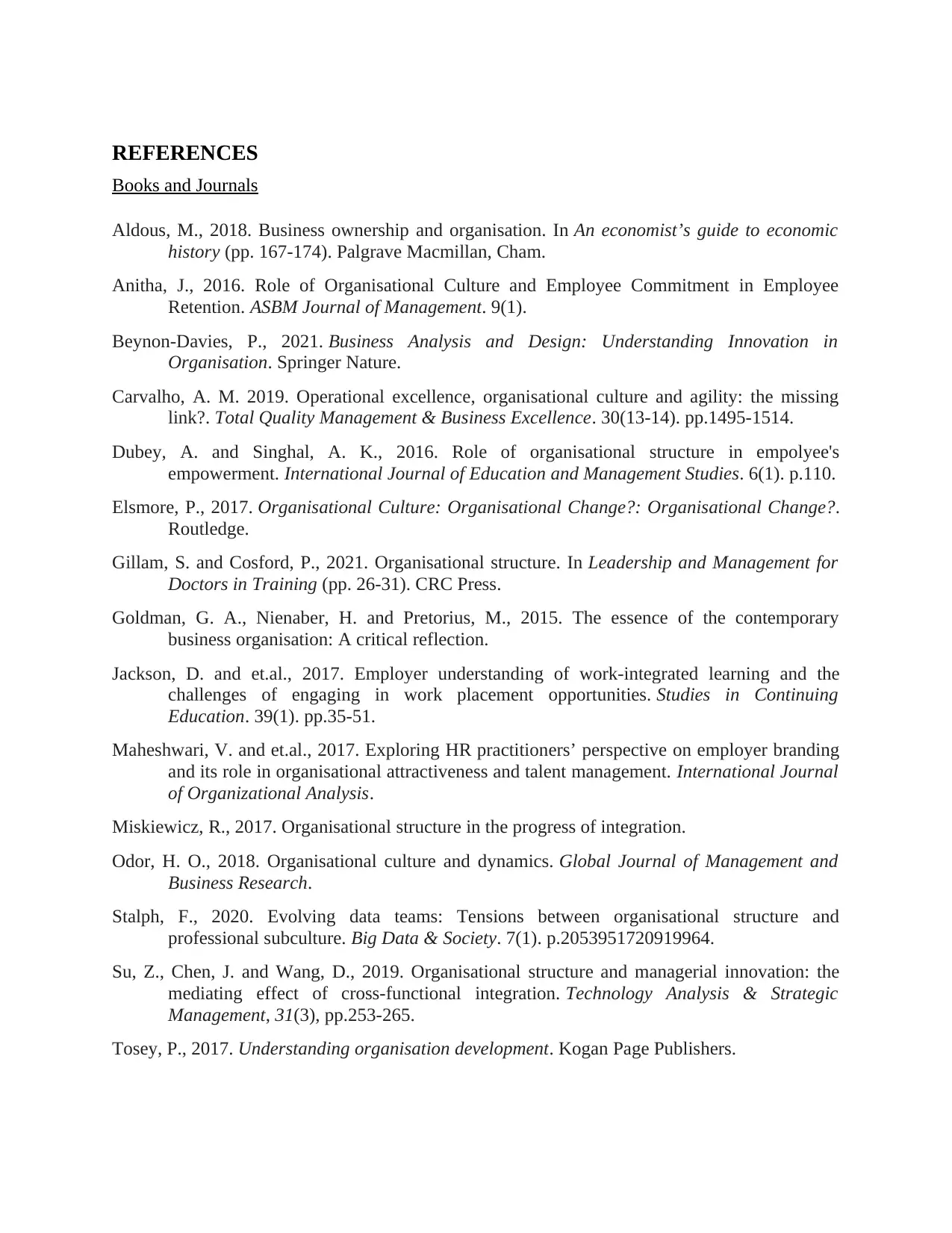
REFERENCES
Books and Journals
Aldous, M., 2018. Business ownership and organisation. In An economist’s guide to economic
history (pp. 167-174). Palgrave Macmillan, Cham.
Anitha, J., 2016. Role of Organisational Culture and Employee Commitment in Employee
Retention. ASBM Journal of Management. 9(1).
Beynon-Davies, P., 2021. Business Analysis and Design: Understanding Innovation in
Organisation. Springer Nature.
Carvalho, A. M. 2019. Operational excellence, organisational culture and agility: the missing
link?. Total Quality Management & Business Excellence. 30(13-14). pp.1495-1514.
Dubey, A. and Singhal, A. K., 2016. Role of organisational structure in empolyee's
empowerment. International Journal of Education and Management Studies. 6(1). p.110.
Elsmore, P., 2017. Organisational Culture: Organisational Change?: Organisational Change?.
Routledge.
Gillam, S. and Cosford, P., 2021. Organisational structure. In Leadership and Management for
Doctors in Training (pp. 26-31). CRC Press.
Goldman, G. A., Nienaber, H. and Pretorius, M., 2015. The essence of the contemporary
business organisation: A critical reflection.
Jackson, D. and et.al., 2017. Employer understanding of work-integrated learning and the
challenges of engaging in work placement opportunities. Studies in Continuing
Education. 39(1). pp.35-51.
Maheshwari, V. and et.al., 2017. Exploring HR practitioners’ perspective on employer branding
and its role in organisational attractiveness and talent management. International Journal
of Organizational Analysis.
Miskiewicz, R., 2017. Organisational structure in the progress of integration.
Odor, H. O., 2018. Organisational culture and dynamics. Global Journal of Management and
Business Research.
Stalph, F., 2020. Evolving data teams: Tensions between organisational structure and
professional subculture. Big Data & Society. 7(1). p.2053951720919964.
Su, Z., Chen, J. and Wang, D., 2019. Organisational structure and managerial innovation: the
mediating effect of cross-functional integration. Technology Analysis & Strategic
Management, 31(3), pp.253-265.
Tosey, P., 2017. Understanding organisation development. Kogan Page Publishers.
Books and Journals
Aldous, M., 2018. Business ownership and organisation. In An economist’s guide to economic
history (pp. 167-174). Palgrave Macmillan, Cham.
Anitha, J., 2016. Role of Organisational Culture and Employee Commitment in Employee
Retention. ASBM Journal of Management. 9(1).
Beynon-Davies, P., 2021. Business Analysis and Design: Understanding Innovation in
Organisation. Springer Nature.
Carvalho, A. M. 2019. Operational excellence, organisational culture and agility: the missing
link?. Total Quality Management & Business Excellence. 30(13-14). pp.1495-1514.
Dubey, A. and Singhal, A. K., 2016. Role of organisational structure in empolyee's
empowerment. International Journal of Education and Management Studies. 6(1). p.110.
Elsmore, P., 2017. Organisational Culture: Organisational Change?: Organisational Change?.
Routledge.
Gillam, S. and Cosford, P., 2021. Organisational structure. In Leadership and Management for
Doctors in Training (pp. 26-31). CRC Press.
Goldman, G. A., Nienaber, H. and Pretorius, M., 2015. The essence of the contemporary
business organisation: A critical reflection.
Jackson, D. and et.al., 2017. Employer understanding of work-integrated learning and the
challenges of engaging in work placement opportunities. Studies in Continuing
Education. 39(1). pp.35-51.
Maheshwari, V. and et.al., 2017. Exploring HR practitioners’ perspective on employer branding
and its role in organisational attractiveness and talent management. International Journal
of Organizational Analysis.
Miskiewicz, R., 2017. Organisational structure in the progress of integration.
Odor, H. O., 2018. Organisational culture and dynamics. Global Journal of Management and
Business Research.
Stalph, F., 2020. Evolving data teams: Tensions between organisational structure and
professional subculture. Big Data & Society. 7(1). p.2053951720919964.
Su, Z., Chen, J. and Wang, D., 2019. Organisational structure and managerial innovation: the
mediating effect of cross-functional integration. Technology Analysis & Strategic
Management, 31(3), pp.253-265.
Tosey, P., 2017. Understanding organisation development. Kogan Page Publishers.
1 out of 9
Related Documents
Your All-in-One AI-Powered Toolkit for Academic Success.
+13062052269
info@desklib.com
Available 24*7 on WhatsApp / Email
![[object Object]](/_next/static/media/star-bottom.7253800d.svg)
Unlock your academic potential
© 2024 | Zucol Services PVT LTD | All rights reserved.



